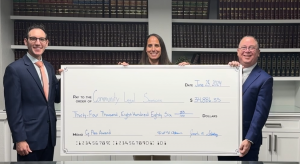Why Women’s Rights Are Vulnerable in America

By Shivangi Misra, Global Legal Advisor at Equality Now
— Shivangi Misra, Equality Now
NEW YORK, NEW YORK, UNITED STATES, March 8, 2024 /EINPresswire.com/ — The US government often takes a strong and vocal position on international human rights violations in other countries. But when it comes to upholding the legal rights of women and girls within its own borders, there is a stark contrast.
The absence of explicit constitutional protection for women leaves them vulnerable to a myriad of abuses. It also makes their hard-won legal rights easier to strip away, as demonstrated by the rollback on women’s human rights in recent years.
This detrimental backtracking and the elevated risk of more discriminatory laws being introduced is because the US Constitution does not sufficiently uphold equality on the basis of sex.
The time is long overdue for the US government to better align its domestic policies with its international rhetoric. This requires reform of the Constitution to ensure equal human rights protection under US law for all citizens, regardless of sex or gender.
THE US CONSTITUTION DOESN’T PROTECT WOMEN’S RIGHTS
Most Americans are unaware that the human rights of women and girls are not secured in the US Constitution. This is despite the impacts being life-changing and wide-ranging.
Girls are disproportionately affected by the absence of a solid legal foundation to challenge and combat harmful cultural practices such as child marriage, which remains legal in 39 states. Over 300,000 minors – some as young as ten years old – were married in the US between 2010 to 2018. Girls account for 86% of these minors, with most wed to adult men.
And while at least 513,000** women and girls are living with or at risk of female genital mutilation, nine US states and the District of Columbia do not have laws prohibiting FGM. Of those that do have laws banning it, many do not outlaw girls being taken out of state to be cut.
Women are more likely to live in poverty and economic insecurity, partly due to the lack of constitutional safeguards. This dearth makes it harder to defend laws that uphold women’s rights when attacked, and there is less protection against workplace discrimination based on gender, pregnancy, or parental status.
In cases involving violations in hiring, remuneration, promotion, and retention practices, legal protections and mechanisms for recourse are insufficient, making it more difficult for victims to access justice.
The knock-on effects push women into being overrepresented in insecure, low-paid, unregulated jobs. This is reflected in the country’s gender pay gap, with women’s wages lower on average compared to their male counterparts. Analysis by the US Department of Labor found that women typically earn 84% of what men were paid.
EQUAL RIGHTS AMENDMENT
For over a century, women have been calling for equality in the Constitution in the form of the Equal Rights Amendment (ERA). This is a proposed constitutional amendment, first drafted in 1923, that seeks to guarantee equal rights and legal protections in the US under the law, regardless of sex or gender. It also specifically prohibits discrimination on this basis.
The proposed amendment succinctly states: “Equality of rights under the law shall not be denied or abridged by the United States or by any State on account of sex.”
Many systemic issues affecting women and girls could be remedied with the adoption of the ERA. It would add explicit prohibition on sex-based discrimination at the highest level, directly impacting the rights of all women and girls in all their diversity.
Since the ERA was proposed over 100 years ago, it has met all the legal requirements for its adoption. However, despite decades of advocacy, the US Government has refused to recognize it as the 28th amendment to the Constitution.
WOMEN’S RIGHTS ARE VULNERABLE TO ATTACK
In the US, discrimination based on religion, race, and national origin is granted the highest, most robust level of judicial review by the legal system, known as “strict scrutiny.” Sex equality must be given this same level of protection.
Without the ERA, basic women’s human rights – such as access to reproductive healthcare and equal protection in cases of sexual and gender-based violence and workplace discrimination – are vulnerable to amendment and repeal.
In June 2022, the US Supreme Court overturned Roe v. Wade, finding that no right to abortion is implicitly protected or conferred by any constitutional provision. This ruling dissolved federal protections on reproductive rights. There has also been a litany of assaults on the rights of trans women.
The ERA would help bridge the gulf between federal and state legislation and would make it tougher for legislative bodies or courts to weaken or overturn established human rights, such as access to abortion and gender-affirming care.
With the ERA in place, laws could face heightened scrutiny, as they would be subjected to constitutional standards of equality. This would empower advocates and lawmakers to push for stronger legislation to prevent abuses like child marriage and FGM and would enable plaintiffs to challenge sex-based discrimination through the courts.
WIDESPREAD CALLS FOR LEGAL REFORM
Today, 85% of UN Member States have a provision in their constitutions that specifically addresses gender equality. The US is not one of them.
In 2023, prominent women’s rights organizations – Alliance for Universal Digital Rights (AUDRi), Equality Now, the ERA Coalition, Unchained At Last, and the U.S. End FGM/C Network – made a joint submission to the UN Human Rights Committee raising concerns about a range of US issues, including child marriage, FGM, and the country’s lack of constitutional equality.
It was heartening to see that the Committee’s review of the US incorporated various points outlined in the submission.
Their remarks included calling on the US to “guarantee protections against sex and gender-based discrimination in its Constitution,” with the incorporation of the ERA. Recommendations also included encouraging states to “pass legislation that prohibits and criminalizes all forms of FGM,” and “prohibit marriage below the age of 18 years.”
In addition, the Committee advised that the US ratify the Convention on the Elimination of Discrimination Against Women (CEDAW) – a crucial international legal treaty that cements nations’ commitment to uphold women’s and girls’ rights. The US remains one of only a handful of countries that have yet to ratify CEDAW.
The US knows what it needs to do. There are no excuses – elected leaders should act now to enact the ERA and strengthen other protections against human rights violations. The world is watching.
We must not tolerate one more child marriage, another FGM case, or the rollback of any other women’s and girls’ human rights. The ERA is a vehicle to ensure everyone’s human rights in the US are protected at the national and state levels and safeguarded into the future.
*****************************************************************
* Child marriage remains legal in 39 US states; for more information go to https://www.unchainedatlast.org/laws-to-end-child-marriage/#:~:text=However%2C%20child%20marriage%20remains%20legal,girls%20wed%20to%20adult%20men.
** At least 513,000 women and girls in the US are living with or at risk of female genital mutilation, for details go to https://equalitynow.org/fgm_in_the_us_learn_more/
Tara Carey
Equality Now
+44 7971 556340
email us here
Visit us on social media:
Facebook
Twitter
LinkedIn
Instagram
YouTube
![]()
Article originally published on www.einpresswire.com as Why Women’s Rights Are Vulnerable in America




